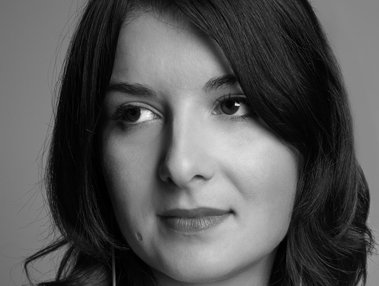Age: 30
Job Title: Designer and artist
Why She’s Top 40: For reimagining the Prairies in sustainable furniture design and bullishly supporting public art.
Key To Success: “In Edmonton, there’s more of a willingness for artists to take chances.”
One good thing happened on July 31, 1987, “Black Friday.” Edmonton gained the future talent of Dara Humniski. Then five, she and her Saskatchewan family wheeled into town under torrential rain and charcoal clouds, and had barely parked the U-Haul when they were scuttled into a family friend’s basement before the angry sky reached for the ground and tore it up.
It’s that same prairie landscape, violent at times, that energizes the designer today. “The province is very beautiful, very varied in its visual inspirations,” says Humniski, a member of the Loyal Loot Collective, four women who met in the University of Alberta’s design program.
Its biggest success, polished ceramic bowls cradled in logs conceived by Calgary’s Doha Chebib Lindskoog, has international sales in the thousands, thanks to endorsements from Oprah, Martha Stewart and Kanye West. The collective’s next launch is Humniski’s vision: A wintery vase with a nub-like farmhouse in seclusion at its top. “Whatever you put in there changes the scale of the house and makes it somewhat magical,” says Humniski (whose other collective, Lad Mags, is a garage-rock band).
Will “Prairie House” be Loyal Loot’s next smash? “There’s definitely pressure in the design world to come up with what’s new and what’s next.” She’s more concerned with making lasting products than pushing out new collections in “unsustainable” fashion.
With a new studio, Humniski, who’s married to artist/journalist and Top 40 alumnus Fish Griwkowsky, is focusing more on her visual art. For two years, she helped lead public art projects at the Edmonton Arts Council before recently leaving for a residency at Winnipeg’s Plug In Institute of Contemporary Art. There, she plotted miniature landscapes around the city (“subtle interventions”) and made a large-scale drawing of patched-together shapes of plants she found throughout Winnipeg.
She’s attracted to public art because it’s “democratic,” but knows from experience that democracy comes with bureaucratic baggage (Talus Dome, anyone?). Media and public become fixed on dollars and placement. But, she begs, “what’s the best place for public art, what defines the best place?” And to those who complain when the city imports designers, she says, “As an artist, I want to work outside the city, so the opposite should happen here.”
